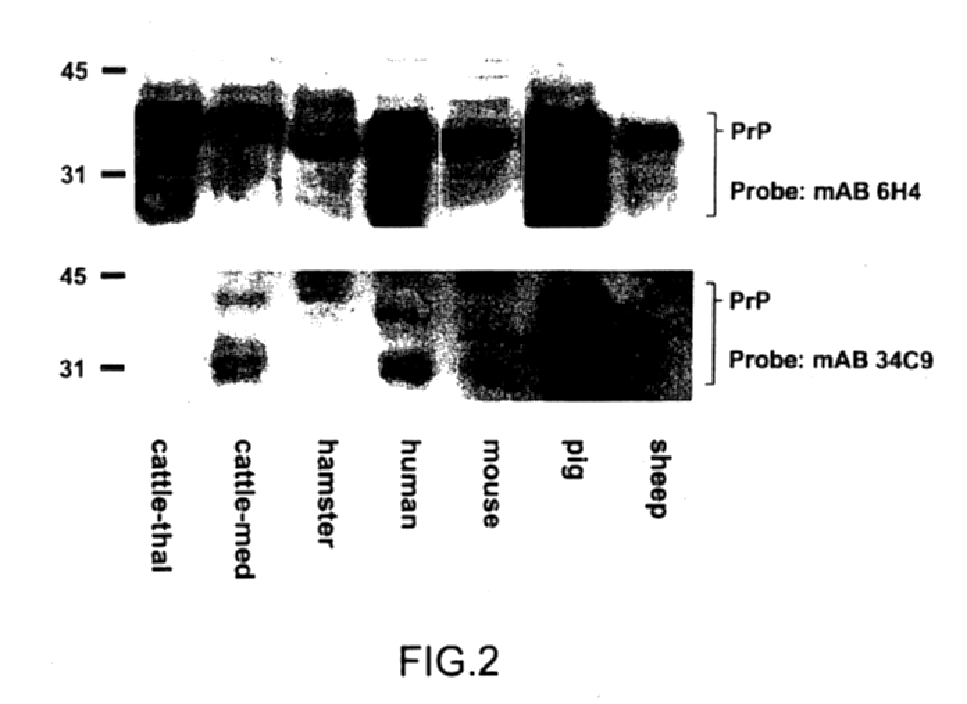Immunological detection of prions
- Summary
- Abstract
- Description
- Claims
- Application Information
AI Technical Summary
Benefits of technology
Problems solved by technology
Method used
Image
Examples
example 1.1
Method for the Preparation of Tissue Homogenates
One gram of brain, either from the thalamus, medulla or spinal cord, were homogenized with an homogenizer (Omni, USA) in 10 ml 10% sucrose, 20 mM HEPES pH 7.5, 2% sarcosyl and 5 mM EDTA. 10% homogenates were diluted 10 fold, one part of the homogenate was digested with proteinase K at 0, 10 or 100 .mu.g / ml. The probe containing 0 .mu.g / ml served as a control for the specificity of the proteinase K treatment. Probes were then further diluted (in PBS) for the ELIFA test to give a blotting concentration of 0.05% of brain homogenate. To increase the partial protease resistance of bovine PrP.sup.Sc, brain homogenates from BSE-infected and normal cattle was diluted after homogenization in 20, 40 or 80% ethanol / HEPES-sucrose buffer. Suspension of brain homogenates in ethanol was an important step and effectively stabilized the .beta.-sheet structure of the PrP.sup.Sc isoform (Oesch et al., 1994), thereby increasing its protease resistance (Ri...
example 1.2
Western Blotting
Tissue specimens were homogenized as described in example 1.1, one part protease-digested, the other not (as described above), diluted to 10% and separated by SDS polyacrylamide gel electrophoresis (SDS-PAGE) on 12% gels (Sambrook et al. 1989). Gels were then electroblotted onto 0.45 .mu.m nitrocellulose (NC) membranes, incubated with the respective monoclonal antibodies followed by a secondary anti-mouse IgG antibody coupled to peroxidase. Bound peroxidase activity was detected with a chemiluminescence kit (ECL, Amersham, USA).
Western blots developed with antibodies 6H4 or 34C9 (FIG. 1A) show the characteristic smear of bands for PrP.sup.C and bovine PrP.sup.Sc (33 to 27 kD) in undigested probes while digestion with proteinase K eliminates all of PrP.sup.C, however, leaving a 27 kD band typical of N-terminally truncated PrP.sup.Sc. The smear is due to different glycosylated forms of PrP.
The present antibodies were furthermore able to detect PrP in various tissue ext...
example 1.3
ELIFA (Enzyme Linked Immuno Filtration Assay)
The ELIFA procedure to determine quantitatively the amounts of PrP.sup.C and PrP.sup.Sc in given tissue homogenates has been described for hamster brain homogenates (Oesch et al., 1994). Blotting directly on nitrocellulose has the advantage over the conventional ELISA procedure that the poor solubility of bovine PrP.sup.Sc does not affect its immobilization on the solid phase. Blotting was performed with an ELIFA apparatus (Pierce), i.e. a peristaltic pump created a vacuum below the NC thereby sucking the contents of the wells above onto the NC in a controlled and highly reproducible way. Wells were then washed with PBS. The membrane was removed from the ELIFA apparatus, placed in a plastic tray and then incubated on a rocking table sequentially for the indicated times with the following reagents (inbetween steps, the filters were always washed 3.times. with PBS): 5% BSA / TBST (30 min), avidin (25 .mu.g / ml, 30 min); biotin (2 .mu.g / ml; 30 ...
PUM
| Property | Measurement | Unit |
|---|---|---|
| Solubility (mass) | aaaaa | aaaaa |
Abstract
Description
Claims
Application Information
 Login to View More
Login to View More - R&D
- Intellectual Property
- Life Sciences
- Materials
- Tech Scout
- Unparalleled Data Quality
- Higher Quality Content
- 60% Fewer Hallucinations
Browse by: Latest US Patents, China's latest patents, Technical Efficacy Thesaurus, Application Domain, Technology Topic, Popular Technical Reports.
© 2025 PatSnap. All rights reserved.Legal|Privacy policy|Modern Slavery Act Transparency Statement|Sitemap|About US| Contact US: help@patsnap.com



